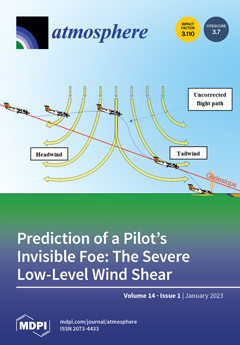Recently, precursor gases such as ammonia have sparked a growing interest in the secondary formation of particulate matter (PM). Most studies focus on urban areas and scientific data. Studies on precursor gases and PM emitted from agricultural sources are insufficient; thus, this paper presents a field monitoring study conducted from agricultural sources. To estimate the effect of precursor gases for PM
2.5 from naturally ventilated dairy barns, correlation analyses were conducted using real-time monitoring data on the mass concentrations of PM
2.5, NH
3, SO
2, NO
2, and H
2S and meteorological data. In addition to mass concentration, the emission and loading rates were used to closely analyze pollution status. The mass concentrations of PM
2.5 and gaseous compounds did not correlate well, whereas the mass emission rates for PM
2.5 and gaseous compounds (SO
2, NH
3, and NO
2) correlated well because the unit of the emission rate reflected the ventilation factor. The correlation coefficients between PM
2.5 and precursor gas emission rates ranged from 0.72 to 0.89 (R), with the SO
2 emission rate exhibiting the highest correlation coefficient (R = 0.89). This correlation implies that SO
2 from dairy farms is a dominant species among the gaseous precursors influencing the secondary formation of PM
2.5; alternatively, SO
2 and PM
2.5 are produced from the same sources. The ambient PM
2.5 loading rate and barn PM
2.5 emission rate—estimated by multivariate linear regression using the gaseous independent variables NH
3, SO
2, and NO
2—revealed high-correlation coefficients (0.60 and 0.92, respectively) with the measured data. At present, most studies investigating the precursor gases of PM in agricultural fields have focused on NH
3; however, this study suggests that SO
2 is a key factor in PM
2.5 pollution. To elucidate the secondary formation of PM from precursor gases in agricultural sources, particulate ammonium, sulfate, nitrate, and chloride, which were not measured in this study, as well as oxidants and intermediates, should be considered in future research.
Full article





